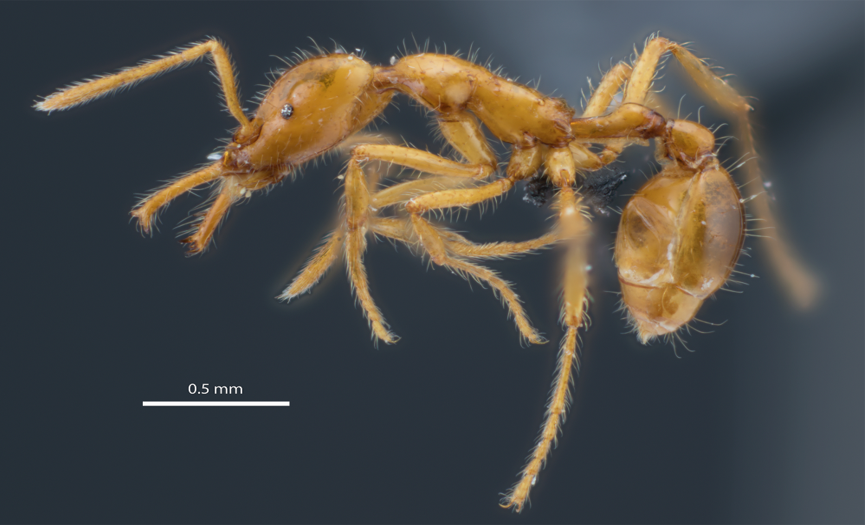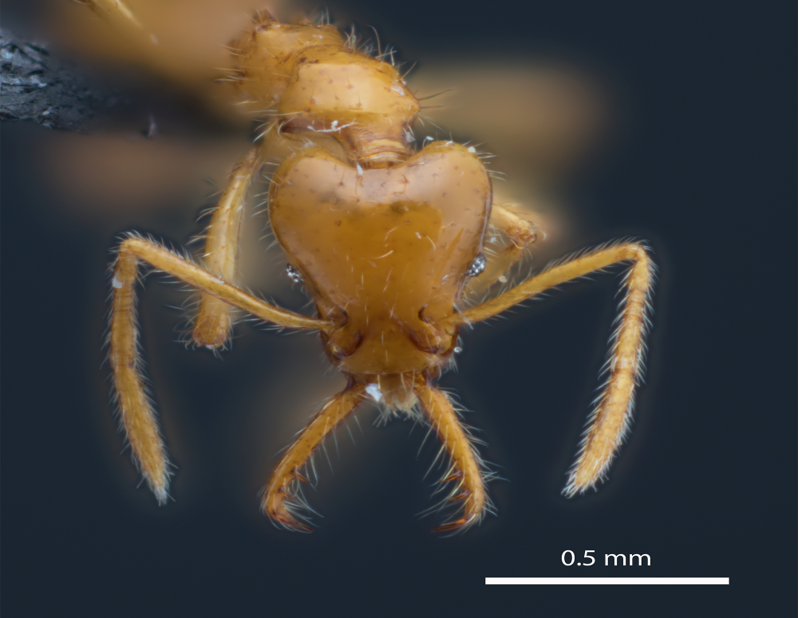
Strumigenys ayersthey. (Image courtesy of Philipp Hönle)

Strumigenys ayersthey. (Image courtesy of Philipp Hönle)
Orginally published in Mongabay.
Scientists describing a new species of ant, Strumigenys ayersthey, have broken with conventional naming traditions and used the pronoun “they” instead of the traditional male or female form to promote nonbinary gender inclusivity.
The new ant, described in a recent paper in ZooKeys, was named after the late artist and human rights activist Jeremy Ayers. Traditionally, a species named after a person would have an “i” appended at the end of the name for males, or “ae” for females; in this case, ayersi or ayersae. Instead, the researchers went with ayersthey.
They did this to honor Ayers and the large number of people who do not identify with either the male and female genders, according to study author Douglas Booher, a Yale postdoctoral researcher, and co-author Philipp Hönle, a doctoral student at the Technical University of Darmstadt, Germany.
“In contrast to the traditional naming practices that identify individuals as one of two distinct genders, we have chosen a non-Latinized portmanteau honoring the artist Jeremy Ayers and representing people that do not identify with conventional binary gender assignments, Strumigenys ayersthey,” the authors wrote in the study.
Ayers was an eclectic artist, publishing photography books, authoring a column in Andy Warhol’s Interview magazine, and writing lyrics for both R.E.M. and the B-52s. Indeed, R.E.M. lead singer and songwriter Michael Stipe joined Booher in writing the etymology section of the paper explaining the decision to use the pronoun “they” to honor the artist. Ayers is remembered today as a fixture of the Athens, Georgia, art community, according to a local paper.
Hönle first encountered the ant while working on his doctoral thesis at Darmstadt, researching ant communities in the Chocó area of Ecuador. Of the specimens he looked at, one stood out for its unique shiny exoskeleton, for which Hönle couldn’t find a matching species. Hönle then contacted Booher, an expert on the ant genus Strumigenys, also known as trap-jaw ants for their trap-jaw mandibles. Booher quickly identified the specimen as a potentially undescribed species, kicking off the work to describe the new ant.
What sets S. ayersthey apart from other ants in the genus is its signature shiny and smooth outer “skin,” or cuticle, as well as its long trap jaws, described by the researchers in the paper as a “biological mousetrap.”
The Strumigenys genus itself is quite diverse. The various species’ trap-jaw mandibles can range from short to long, with the newly described species having large mandibles; some species lack the trap jaw entirely. One common identifying feature of the genus is a sponge-like structure toward the base of the abdomen. According to Booher, the function of the sponge structure remains a mystery to scientists.
In a study published in PLOS Biology in March 2021, Booher explores the evolution of the trap-jaw mechanism and its gradual increase in length. The trap-jaw mechanism itself is one of the fastest movements in any living creature, with the jaws snapping shut at a rate of up to 1.2 million meters per second squared.

The newly described species is found in the Chocó region of Ecuador, a biologically rich and diverse coastal rainforest that is simultaneously understudied and under threat due to human activities. Logging, mining and oil palm plantations have resulted in a 61% reduction of the Chocó region’s forests.
“[The Chocó] features a plethora of endemic species. There is one critically endangered subspecies of [brown-headed] spider monkey, Ateles fusciceps fusciceps, that only lives in the forests of this part of Ecuador,” Hönle said. “However, the insect fauna and especially the ants there are poorly known, as only very few researchers did sample the area.”
The region is so understudied that last year Hönle and other scientists described another species of native ant, Odontomachus davidsoni, calling this one “large and conspicuous.”
Hönle’s fieldwork collecting specimens in the Chocó takes place on land preserved by Jocotoco, an NGO that buys threatened land to conserve it.
“The fact that no one has described this species before highlights how much else might be out there. The new Strumigenys is just one more little piece toward a more complete understanding of the fauna,” Hönle said.
––
Booher, D. B., Gibson, J. C., Liu, C., Longino, J. T., Fisher, B. L., Janda, M., … Economo, E. P. (2021). Functional innovation promotes diversification of form in the evolution of an ultrafast trap-jaw mechanism in ants. PLOS Biology, 19(3), e3001031. doi:10.1371/journal.pbio.3001031
Booher, D. B., & Hönle, P. O. (2021). A new species group of Strumigenys (Hymenoptera, Formicidae) from Ecuador, with a description of its mandible morphology. ZooKeys, 1036, 1-19. doi:10.3897/zookeys.1036.62034
Hönle, P. O., Lattke, J. E., Donoso, D., Von Beeren, C., Heethoff, M., Schmelzle, S., … Blüthgen, N. (2020). Odontomachus davidsoni sp. nov. (Hymenoptera, Formicidae), a new conspicuous trap-jaw ant from Ecuador. ZooKeys, 948, 75-105. doi:10.3897/zookeys.948.48701